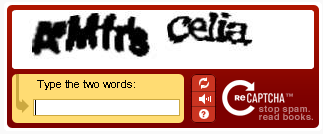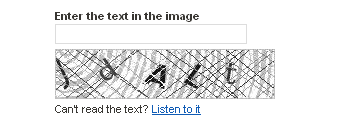Web Form Validation: Best Practices and Tutorials
Ideally, users will fill the web form with necessary information and finish their job successfully. However, people often make mistakes. This is where web form validation comes into play. The goal of web form validation is to ensure that the user provided necessary and properly formatted information needed to successfully complete an operation. In this article we will go beyond the validation itself and explore different validation and error feedback techniques, methods and approaches.
Are you human?
Web form validation wouldn’t be complete without mentioning Captcha. Captcha is a significant part of validation as it is responsible for finding out if the user of a system is a human or a bot. In its simplest form, captcha consists of an image showing text, numbers or an expression and a field that expects content of the image as input. The earliest captcha generated images with numbers (e.g. “8356″) and that number was expected to be entered by the user. If correct number wasn’t entered (or not entered at all), the form couldn’t be submitted. In fact, today most spam bots are able to recognize the text embedded in a simple captcha-image, so it’s a good idea to pose some question that only humans could answer correctly, e.g. “What color does the Sun have?” with correct answer “yellow” in all its variations (”YELLOW”, “yellow”, “Yellow” etc.).
You may also want to consider the technique called Honeypot Captcha where the idea is to create hidden form elements and check on the server side that they remain blank. Another option is to create a form field with a label that says, “Leave this field blank” and then is marked as a required field (thank you, Shawn McCool).

Simple captcha requires an answer to a semantic question.
The kind of captcha presented above caused a major problem in accessibility. Blind, visually impaired or dyslexic users have difficulties or are even impossible to complete the web form with Captchas. As the Web evolved, so did captchas and today there are implementations like ReCaptcha that have audio support for users with disabilities.

Captchas can show hardly recognizable words. Can you easily read the word on the left?
Still most users hate captchas (and there is a good reason for hating them!). Of course, people just don’t like filling in forms. If they can’t do it fast and effortlessly, there is a high probability that they won’t do it at all. This is where a captcha doesn’t help at all: it can take too much time for users to read (if text is messy) which happens oft in practice. Remember, Captcha helps site owners, not their users. Therefore it’s always a good idea to avoid using Captchas if you can avoid them. To read more about Captchas and accessibility, read Inaccessibility of CAPTCHA.
>
Captcha on Digg registration form has audio support. If unable to read, users will be able to hear the letters shown in the image.
Useful resources
Here are some of the frameworks, plugins and tutorials that might help you easily implement validation in your forms.
- LiveValidation
A small, open source JavaScript validation library. It enables real-time, rich client validation which can be implemented easily. The best way to see its capabilities is to check out the example page. - Validanguage
A validation framework that enables rich client-side validation. - JavaScript Form Validation
A JavaScript validation framework for creating inline validation. You can configure it through JavaScript code or by using XML configuration file. - PhatFusion Validate
A small JavaScript validation framework based on MooTools. - UniForm
An attempt to standardize form markup (xhtml) and CSS. It can help you style error messages, help text, indicators and so on. - jQuery Validation plugin
One of the most popular validation plugins. As expected from jQuery plugin, it enables validation in one line of code, but you can also customise it. It has only 14 kb and is compatible with jQuery 1.3.2. - jForm
Another jQuery plugin that lets you implement validation easily. Not only that it performs validation but also has the support for live tips. It is still in development phase but is worth checking. - Dynamic JavaScript Form Validation
Provides easy validation and attractive error messages. - jQuery Form Validator
Another great jQuery validation plugin that performs live validation. It is fully customisable and supports localisation as well. - Form field hints with CSS and JavaScript
A useful tutorial on how to create help tips using CSS and JavaScript. Demo and source are included. - Validation Hints for your form
A great tutorial from Ask The CSS Guy that shows how to create inline validation with CSS and JavaScript. - Screencast: Quick PHP Form Validation with PEAR
A nice example of how you can validate PHP forms using PEAR framework. - PHP Contact Form with jQuery Validation
This tutorial shows how to implement the validation of a contact form using PHP and JavaScript. - How to Validate Forms on both sides using PHP and jQuery
Shows how to implement both client-side and server-side validation using PHP. - Adding Form Validation to WordPress Comments using jQuery
An interesting tutorial for all Wordpress users.
Conclusion
You saw different methods and techniques that you can use to implement validation in your forms. Although there are many possibilities, you should carefully plan validation for each project. Not all techniques provide a solution for everything. Some of them are very helpful and easy to implement, but some lack usability and simplicity. If you are new to web form design here is a short list of what to consider in Web form validation design). That might be enough for you to start.
Rules of thumbs in web form validation design
- Never omit server-side validation.
- Don’t provide confusing validation feedback. It should clearly communicate the errors and ways to fix them.
- Don’t let users think about what information is required, always clearly mark required fields.
- Never provide validation feedback on a single page or in a popup alert.
- Don’t use dynamic effects as compensation for a badly designed form. Fancy effects won’t hide a poorly designed web form.
- If you use Captcha, don’t forget to provide audio support and enable users to “reload” the Captcha.
- Don’t forget to inform users when the form was completed successfully. It is as important as a good validation feedback.